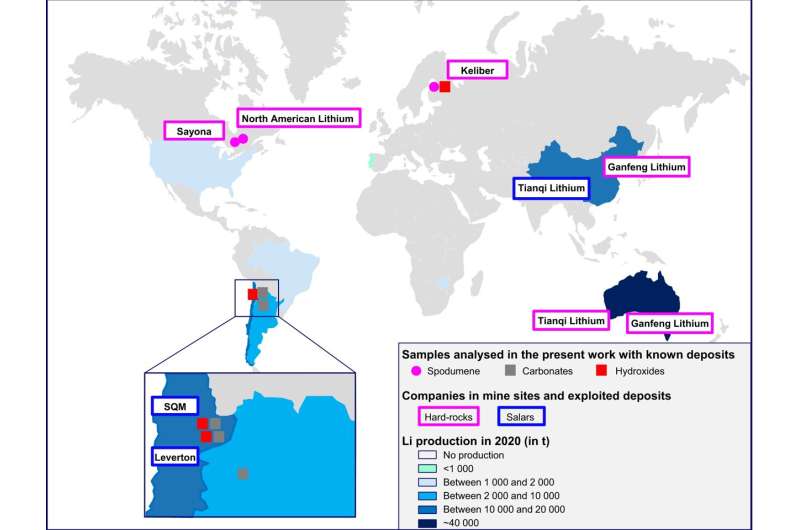July 27, 2022 report
A possible way to trace the source of lithium used in electronics to confirm it comes from an ethical source

A team of researchers with members from BRGM, Orléans, EDF, EDF R&D, 77818, Moret sur Loing and Université Grenoble-Alpes, all in France, has found a possible way to trace sources of commercial lithium to determine whether it comes from an ethical source. In their paper published in the journal Nature Communications, the group describes their study of the possibility of using lithium isotopic signatures to trace its roots.
Modern technology is heavily dependent on lithium, a soft, silver-white metal used in batteries for smartphones, computers and cars. Lithium is mined and processed to make it useful. In recent years, there have been reports of unethical activities at lithium mines, such as mistreatment of miners, overuse of freshwater sources and the destruction of local ecosystems. Because of such behavior, there have been calls to ban the use of lithium from such sites or for consumers to boycott products made using lithium from these sources. The problem is that there is no real way to trace the source of lithium. Currently, lithium production and lithium use are tracked through information in databases and documented in paperwork, but both sources can be easily faked. In this new effort, the researchers noted that lithium from different mines is likely to have different isotope ratios, which can be used as signatures, possibly making them traceable.
More specifically, the researchers noted that lithium has two stable isotopes—lithium-6 and -7, and that the ratios of the two in a given sample of lithium varies from site to site. These ratios, they note, are due to environmental conditions. To find out if the ratios are different enough to use as source signatures, the researchers analyzed data from other research efforts involved in the study of lithium, noting particularly the isotopic ratios and where the samples came from. The researchers were not able to come up with a definitive answer but suggest the evidence suggests that the ratios are different enough to constitute a signature. They note that it should be possible for someone to collect samples directly from most, if not all, of the existing lithium mines to measure their ratios and to confirm whether they are different enough to use as a sourcing signature.
More information: Anne-Marie Desaulty et al, Tracing the origin of lithium in Li-ion batteries using lithium isotopes, Nature Communications (2022). DOI: 10.1038/s41467-022-31850-y
© 2022 Science X Network

















